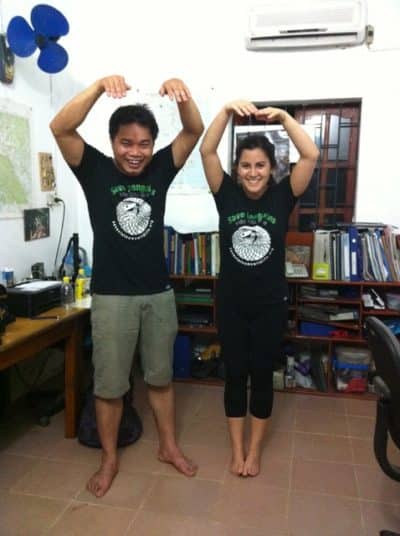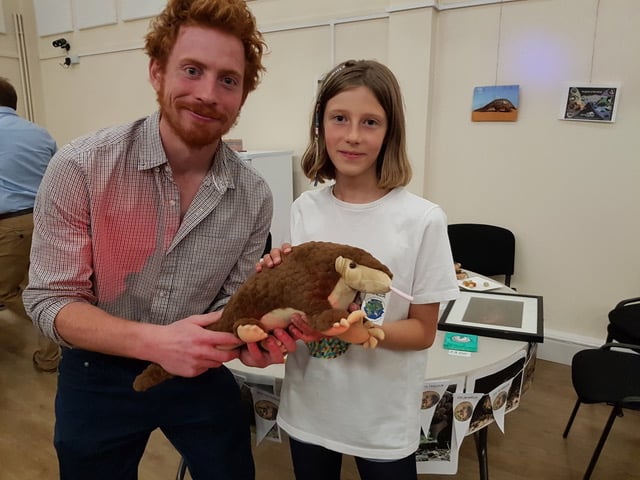I was in a national park in Northern Vietnam, surrounded by buzzing insects and croaking frogs, my shirt damp and hair frizzled with humidity when I first saw a pangolin. It was a pangolin rescued from the illegal trade, too injured to be released back to its jungle home. While the pangolin climbed out of a tree trunk, nose first, sniffing the air for its meal of ants and termites, I stood rooted to the spot, too mesmerized to move. Worried that I might scare it away, I crouched to get a better look of its every movement: its tear-stained eyes (to offer protection from ants), the slight twitches of its snout, the way its scales moved with every raise of its legs.
I think I might have even been holding my breath, from excitement and the immediate realisation that pangolins don’t smell great. I followed the pangolin with my eyes as it finished its dinner, still rooted to the spot. The tingly, horrible feeling of antennas and legs at the back of my neck, brought me back to my senses. I turned to my right shoulder just in time to see a cockroach scurry down my arm. I wanted to jump, yelp and brush it off, repulsed but that could scare the pangolin. Horrified I watched it crawl to my elbow and jump off. That is how far I am willing to go to watch a pangolin: I’ll even let cockroaches crawl on me.

Photo Credit: Alegria Olmedo
In the last five months, pangolins have weaved in and out of COVID-19 related news. We have been bombarded by news on how the virus originated, how it spread across the world, how our own government is doing too much or too little, how we could become infected and infect others – it is impossible not to get overwhelmed. What makes it worse, though, is not knowing what is real and how to make sense of it all.
We heard the virus originated in a ‘wet’ market in China, referring to markets where they sell live and dead domestic and wild animals among fruits, vegetables and other types of food. The first round of news said the virus originally came from a bat, then jumped to a different animal (suspected to be a pangolin, my scaly, nocturnal friend!), and then to humans. Whether it was by eating an animal, being in contact with raw or cooked meat or by being near it, was unknown. Since then, it has become unclear if it was a bat at the market, or whether a person had contracted the virus elsewhere (likely still from a bat) and then spread it in the market. The evidence that pangolins were involved is weak and the truth is we probably won’t ever know exactly how humans first contracted the virus.
The links between COVID-19 and these markets have resulted in many organisations and people asking for the closure of such markets and for an end to the hunting, selling and buying of wildlife. The main reasons are to protect human health and keep wildlife in the forests.

Alegria and Nguyen Van Thai, Executive Director of Save Vietnam’s Wildlife, rolling like pangolins.
Prohibiting the hunting, buying and eating of pangolins, turtles or monkeys does not affect me, my family or any of my friends. We don’t rely on these animals for food, we do not live close to forests and we would have to travel pretty far to see them anywhere other than in a zoo. But millions of people in the world do rely on these animals for food, medicine and other purposes; some rely on hunting for meat and others rely on markets to buy meat or medicines made from animals and plants.
The truth is that it is not just exposure to wildlife at a market that has put us all at the risk of a pandemic. Viruses are known to jump from wild animals to domestic animals, like pigs, and then to humans. Domestic animals and wildlife not only come into contact in wet markets, they come into contact when we cut down forests to set up farms, when we take up more and more space for ourselves and neglect the space wildlife and nature needs. It is the combination of many of our actions and practices that have led to the outbreak of COVID-19 and the resulting pandemic.
However, this pandemic has not only led to fear and worry across the world, but it has also risen the question ‘how did we get here?’. The answer is not pointing the finger at people in faraway countries who buy and eat different products; we will all continue creating problems for ourselves until we accept that we need to live differently. We must see the bigger picture in the long-term and avoid returning to our usual lives as soon as life returns to ‘normal’.
It is the time to press the Reset button on our relationship with nature. Considering the origin of the products we buy and eat, thinking about the companies and leaders that we, and our families, support and reflecting on the messages we share with others can highlight the practices in our own lives that could change to support the health of our planet and the people in it. Realising that our own vulnerability as humans relies on the choices we make is the most important lesson we can take from this.
It’s also important to highlight that no one should ever feel too young to do something. When I was a student, two friends and I created People for Pangolins, a non-profit dedicated to raising awareness and funds for pangolins. It started as a Facebook page and a challenge for World Pangolin Day. Since then we have donated to efforts to rescue pangolins from being illegally traded, to help them recover and be released back to the wild in Vietnam and South Africa.
There are so many depressing and scary nature stories and news that a creative, inclusive activity that helps people enjoy themselves can go a long way. We can all think of ways to rebalance our relationship with nature and inspire others to do the same.

Elliot Newton, the co-founder of People for Pangolins with a super-enthusiastic pangolin-lover, Ellie, who organised a Pango-Gin event.


